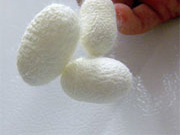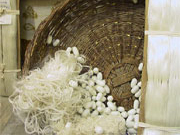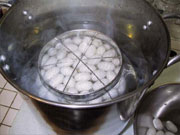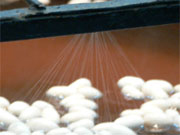The Bombyx Mori silkworm: the source of silk
Silk, a fabric admired for centuries for its softness and sheen, owes its existence to a remarkable insect: the silkworm. This small but impressive caterpillar has a very specific preference when it comes to food. It only enjoys the leaves of the mulberry tree, making it a picky eater.
The Bombyx Mori is the most commonly used silkworm due to its impressive cocoon. It contains a thread of 2500 to 3500 meters long! The middle part, about 1000 to 1500 meters, can be unwound in one piece. We call this reeled silk. From the remaining shorter pieces, we make spun silk, also known as waste silk.
From caterpillar to cocoon: a remarkable transformation
During its development into a butterfly, the silkworm undergoes a remarkable process. It spins a cocoon around itself, made of fine threads that it produces itself. These threads are joined together with a natural glue that the caterpillar secretes. The result is a protective cocoon in which the caterpillar can develop.
Harvesting silk: a delicate process
Unfortunately, traditional silk production involves a less pleasant aspect. To keep the silk threads intact, the caterpillar is killed before it can emerge as a butterfly. This happens when the cocoon is ready, but the butterfly has not yet emerged.
From cocoon to thread: degumming
Before the silk thread can be used, it must first be treated. This process is called 'degumming'. During this process, the adhesive substance, also known as sericin, is boiled out of the silk. Once the glue has melted, special brushes can be used to carefully unwind the thread. This thread forms the basis for the silk yarn we know.




An animal-friendly alternative: wild silk
For those looking for a more ethical option, there is wild silk, also known as tussah silk. This silk comes from cocoons of wild silkworms that have already flown out as butterflies. Because the butterfly has left the cocoon, it is damaged. As a result, the threads can no longer be unwound as one long thread. Nevertheless, this produces a unique and valuable product.
The value of silk
Silk remains one of the most valued natural fibers in the world. Whether it's traditional or wild silk, both have their own charm and applications. The production of silk is an art that has been practiced for thousands of years and still manages to fascinate people with its beauty and softness.
The unique properties and benefits of silk at a glance:
Silk is a special material with many advantages. Let's look at the characteristics that make silk so special:
- A natural wonder: Silk is a pure natural product. It comes from the cocoon of the silkworm. This makes it a sustainable choice for those who prefer to use natural materials.
- Soft and comfortable: When you touch silk, you immediately feel how soft it is. It feels wonderful on your skin, making it perfect for bedding and clothing worn directly on your skin.
- Skin-friendly: Do you have sensitive skin or suffer from allergies? Then silk is a good choice. The material is very skin-friendly and rarely causes irritations.
- Regulates moisture and temperature: Silk can absorb a lot of moisture (up to 40% of its weight!) without feeling wet. It also helps your body maintain its temperature. In summer it keeps you cool, in winter warm.
- Lets your skin breathe: Because silk is breathable, it helps prevent excessive sweating. Your skin can breathe freely under silk clothing or silk bedding.
- Low chance of allergic reactions: Silk is naturally hypoallergenic. This means it is less likely to cause allergic reactions. It is also less attractive to dust mites and molds.
- Stylish and elegant: With its beautiful sheen, silk gives a luxurious appearance. It adds a touch of refinement to your clothing or interior.
- Long-lasting: Silk is stronger than you might think. If you take good care of it, it retains its shape and beauty for a long time. This way, you can enjoy your silk items for years.
- Easy to care for: You can wash silk in the washing machine, as long as you do it carefully. It dries quickly and retains its shape without much wrinkling.
Due to all these properties, silk is a versatile and beloved material. Whether you use it for clothing, bedding, or accessories, silk offers comfort and style in one.
Types of silk
Silk fabric exists in a large number of forms, an overview of the most common types:
- Satin silk
- Silk jersey
- Chiffon silk
- Habotai silk
- Silk "Crêpe de Chine"
- Georgette silk
- Jacquard silk
- Bourette silk
- Dupion silk
- Tussah silk / wild silk
- Organic silk
Maintenance of silk
What is the best way to wash silk? You can find more information here.
